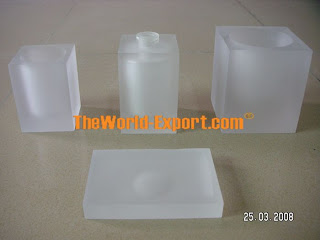Thought at the beginning of the day:
to use a material that would disintergrate somehow as the outside weather would change the balance of that form and make it collapse, but just incase im going to look at durable materials aswell.
Plastrer

Casting Resins
Clear Poly Resin Art Craft
Clear and light weight makes clean cut edges. This would be a good material to use = easy to pick up, wont fall apart so will be good outside. However the fact that the material doesnt change over time may be less exciting... but then again because the blocks would be around longer would mean you had more time to mess about with them so then therefore more balance inquiry would be made.
German painter Markus Linnenbrink drills holes into layers of colored epoxy resin, creating pockmark-like craters in dimensional paintings that are busy and alive with color. They have the feel of optical illusions…makes my head spin.
Engadget brings us this exploded iPod (that poor site is getting beat up today), which has been dissembled and placed in a protective block of carbonite translucent resin
Waxes
Paraffin Wax has a cloudy transparent colouring, is manmade and derived from oil. It is cheap (often used in candle making and has a lower melting point of around 55ºC (131ºF). In the encaustic art blocks is used to decrease the viscosity (make it run more easily when molten).
Carnauba Wax melt point about 80C - A natural plant wax of golden colour included to raise the melt point, add a little hardness. It also improves the polishing shine of the wax.
Beeswax is a natural product containing many ingredients derived from the locality of its origin. Pollens and oils affect the odour, colour and nature of the wax, but generally speaking beeswax melts at about 62ºC (144ºF). It is the basis of all the Ancient's encaustic paints and some definitions require its inclusion for a mixture to be a true encaustic medium.
Micro Crystalline waxes - Encaustic Art blocks use one that melts at 68 C - a by product wax of oil origin, this wax type offers adjustment to the melting point and the viscosity of the wax as well as the heat curve that affect the way the wax congeals back into a solid.
"At three metres tall and two and a half wide, the block is too big to fit through the doors, so it will deposit wax on the frames as it squeezes through."
He uses a very malliable soft wax so it moulds through the door easily... this is a possible material as when the wax is balanced on eachother it would then if sunny melt outside and fall over ... the balance being altered and thefore fallin over, creating a new form.
Metals
Bronze
Pewter
Alloy metal use to contain lead but due to harmful nature of leasd putter only contains Tin, Antimony, and copper. It is silver in colour and can be polished well to make it look like silver. Pewterhowever is a heavy material and so may not be good for my project (also expensive).
Aluminium
Most abundant metal in the Earths crust therefore it is cheap. It has a low density and therefore is light. Also resists corrosion.
Aluminium is a soft, durable, lightweight, ductile and malleable metal with appearance ranging from silvery to dull gray, depending on the surface roughness.
Although it is light weight i am not sure if it is light enough to allow people, of all ages, to pick up the blocks even if they were hollow.
Iron
Rusts, would take a long time to decompose but it could be monitored over years and become part of the project. Exciting decay. Magdalena Abakanowicz has reliey on the rusting of iron to be "like a tree bark or wrinkled face expressing a different individuality of each sculpture"
http://www.abakanowicz.art.pl/
Stainless Steel














No comments:
Post a Comment